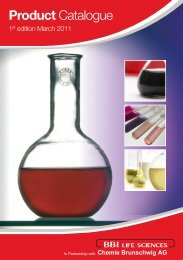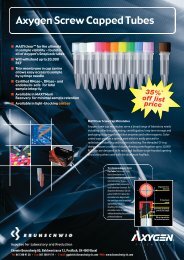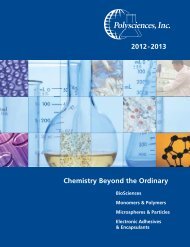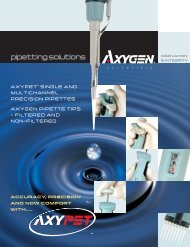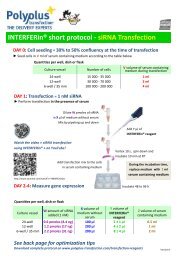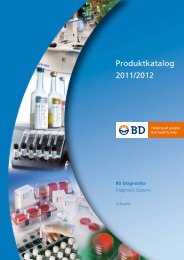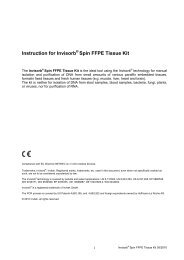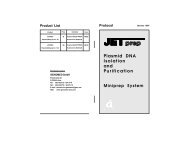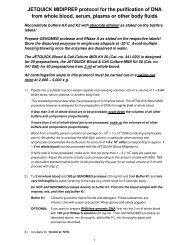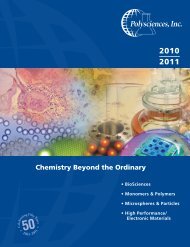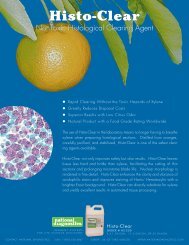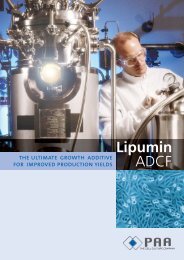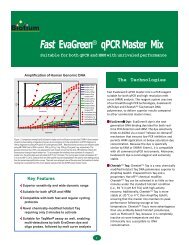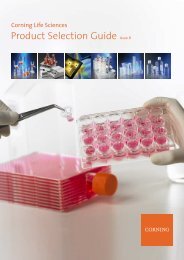JetQuick Protocol DNA Purification from whole blood, serum, plasma ...
JetQuick Protocol DNA Purification from whole blood, serum, plasma ...
JetQuick Protocol DNA Purification from whole blood, serum, plasma ...
Create successful ePaper yourself
Turn your PDF publications into a flip-book with our unique Google optimized e-Paper software.
JETQUICK protocol for the purification of <strong>DNA</strong> <strong>from</strong> <strong>whole</strong><br />
<strong>blood</strong>, <strong>serum</strong>, <strong>plasma</strong> or other body fluids<br />
Reconstitute buffers KX and K2 with absolute ethanol as stated on the bottle‘s<br />
label!<br />
Prepare GENOMED protease and RNase A as stated on the respective labels! Store<br />
the dissolved enzymes in single-use aliquots at -20°C. Avoid multiple freezing/<br />
thawing once the enzymes are dissolved in water.<br />
The JETQUICK Blood & Cell Culture Kit 50 (Cat. No. 440 050) is designed for 50<br />
preparations, the JETQUICK Blood & Cell Culture Kit 250 (Cat. No. 440 250) for 250<br />
preparations <strong>from</strong> 200 µl of <strong>whole</strong> <strong>blood</strong>.<br />
1.) Pipette into a 1.5 ml or 2.0 ml reaction tube (i.e. Eppendorf) up to 200 µl of <strong>whole</strong> <strong>blood</strong>, <strong>serum</strong>, <strong>plasma</strong>,<br />
buffy coat oder another body fluid.<br />
2.) Add 20 µl GENOMED protease (20 mg/ml) and 200 µl Buffer K1 to this sample and mix very<br />
thoroughly either by vortexing or by inverting of the tube.<br />
Do NOT add GENOMED protease directly to buffer K1. First mix the <strong>blood</strong> sample with the<br />
enzyme, mix, then add buffer K1.<br />
Buffer K1:<br />
Contains guanidine hydrochloride and a detergent. These substances are irritants. Use<br />
with proper precaution! Wear gloves and safety goggles!<br />
OPTIONAL: If one wants to prepare RNA-free genomic <strong>DNA</strong>, add 10 µl of RNase A solution (20<br />
mg/ml) prior to the addition of buffer K1.<br />
3.) Incubate for 10 min at 58°C.<br />
4.) Add 200 µl of absolute ethanol to the mixture and mix immediately and very thoroughly in order to<br />
prevent any precipitation of nucleic acids due to too high local alcohol concentrations.<br />
Do not use other alcohols than ethanol, because other alcohols may cause inconsistent yields.<br />
5.) Assemble a JETQUICK micro-spin column with a 2 ml receiver tube. Apply the sample <strong>from</strong> step 4 into<br />
the JETQUICK micro-spin column without moistening the rim of the micro-spin cup and centrifuge the<br />
sample for 1 min at 10.000 x g (approximately 10.600 rpm) through the silica membrane.<br />
6.) Discard the flowthrough, re-assemble the Micro-Spin unit with the receiver tube and wash the<br />
JETQUICK column by applying 500 µl buffer KX reconstituted with ethanol and centrifuging for 1<br />
min at 10.000 x g (approximately 10.600 rpm).<br />
7.) Discard the flowthrough, re-assemble the Micro-Spin unit with the receiver tube and wash the<br />
JETQUICK column by applying 500 µl buffer K2 reconstituted with ethanol and centrifuging for 1<br />
min at 10.000 x g (approximately 10.600 rpm).<br />
1
8.) Discard the flowthrough, re-assemble the micro-spin and the receiver tube and centrifuge the empty<br />
tube again for 1 min at full speed (∼13,000 rpm) in order to clear the silica membrane <strong>from</strong> residual<br />
liquid.<br />
9.) Insert the JETQUICK micro-spin tube into a new, sterile 1.5 ml reaction tube and elute the <strong>DNA</strong> <strong>from</strong> the<br />
membrane with 200 µl of 10 mM Tris-HCl buffer (pH 8,5) or simply water.<br />
The elution buffer should be used prewarmed to 70°C and pipetted directly onto the center of the silica<br />
membrane. Take care that the <strong>whole</strong> membrane comes into contact with the elution buffer.<br />
Incubate the spin column for 2 min at room temperature after application of the elution buffer and<br />
centrifuge subsequently for 2 min at 10.000 x g (approximately 10.600 rpm). The eluate now contains<br />
the pure <strong>DNA</strong> that can be further processed immediately.<br />
Yield can be increased by up to 15% doing a second elution step with the same 200 µl of <strong>DNA</strong>containing<br />
eluate. Preheat the 200 µl of eluate to 70°C, fill it into the micro-spin device and proceed as<br />
described before.<br />
If lower <strong>DNA</strong> yields (< 3 µg) are to be expected, the volume of the elution buffer can be reduced to 100<br />
µl in order to obtain a higher <strong>DNA</strong> concentration in the eluate.<br />
For expected <strong>DNA</strong> yields that are even < 1 µg, one can consider the reduction of the elution buffer<br />
volume to 50 µl. However, any reduction of the elution buffer volume will lead to a somewhat reduced<br />
overall <strong>DNA</strong> yield of approximately 10-15%.<br />
2



